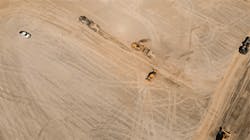GPS Improves Output from 500K to 2M Yards of Dirt
RV Associates has implemented machine-control technologies across its site-building business, and increased its production nearly four-fold. In this video case study from Leica Geosystems, company officials explain how technology is sharpening its competitive edge.
The company has 85 employees and more than 150 pieces of equipment, says Rob Lumsden, VP. He says technology was a “no brainer” as a strategy to become more that “one value-add niche higher.” The company latched onto GPS machine control as a means to improve efficiency.
“The line of engineer/survey/construction company are starting to blur,” says Jacob Daniel, GPS data manager. “An average construction company can now design and do somewhat survey in the field without having to spend thousands of dollars.”
“Our best year that we had moving dirt before we go machine control was probably about 500,000 yards, says Dan Wolfard, operations manager. “Last year, we moved between a million and a half and 2 million yards of dirt. I don’t think that we would have been able to do it with the people that we could find without the machine controls and the GPS system. It would have been an astronomical amount of stakes to put in, and the surveyors would have never been able to keep up.”
In addition to the labor cost, you only grade it once with GPS, says Craig Moore, superintendent. “It’s one and done. You make one pass, to grade, and you’re done. You don’t go back. It saves wear and tear on my equipment, going through less undercarriages, less blade wear.”
RV Associates stores data on Leica’s cloud service, says Daniel, which means everyone can access it wherever they are.
On a bigger project, where there are a lot of revisions or we get added work,” says superintendent David Wolfard, “instead of having to drive an hour and half back to the office and get a file on a thumb drive, you can send it right over, load it into the machine, and we’re working in a couple of minutes.”
Leica also allows for remote support, says Daniel. He can log into the tablet, take control, and fix the errors.
David Overland, project manager, says the biggest advantage is that the operator knows, “with confidence, what he’s doing.”
“He might have heard about a change, or about some kind of design that’s coming,” Overland says, “but now he knows. It’s right in front of him. It’s going to be much more accurate.”
David Wolfard says the company was expecting the technology to help inexperience operators, but was surprised to see the efficiency improvements for seasoned operators increase by two to three times.
“If you can already feel what a dozer’s doing underneath you, and then put the machine control on,” he says, “and all the information’s on the screen right in front of you...that makes a huge difference.”
The company chose Leica because it was the most user-friendly, according to Dan Wolfard.
Customer service also has been positive. “We always have answers within hours, at the most,” he says.
